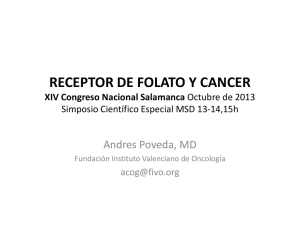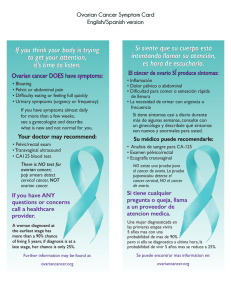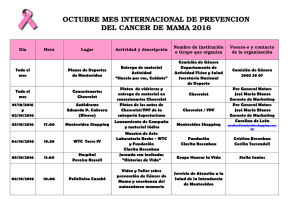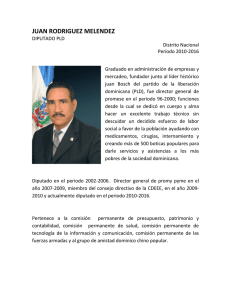Diapositiva 1
Anuncio
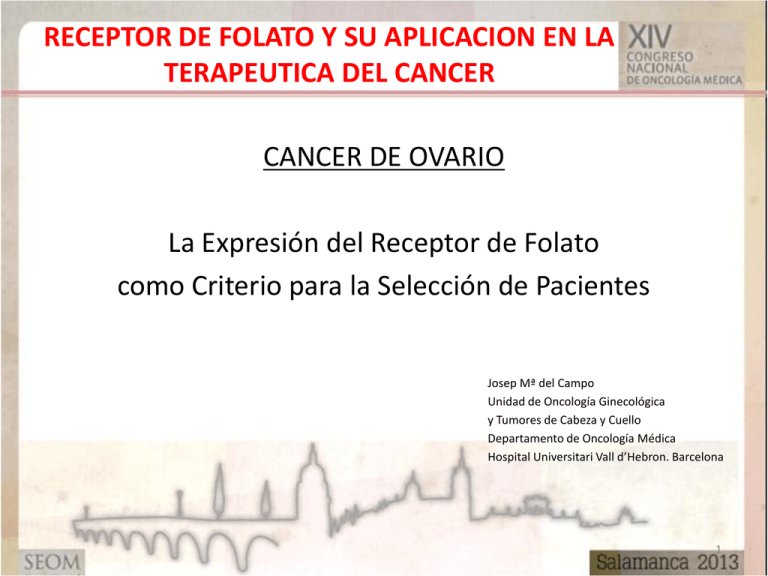
RECEPTOR DE FOLATO Y SU APLICACION EN LA TERAPEUTICA DEL CANCER CANCER DE OVARIO La Expresión del Receptor de Folato como Criterio para la Selección de Pacientes Josep Mª del Campo Unidad de Oncología Ginecológica y Tumores de Cabeza y Cuello Departamento de Oncología Médica Hospital Universitari Vall d’Hebron. Barcelona 1 Cáncer Avanzado de Ovario • El cáncer de ovario es la primera causa de muerte entre las neoplasia ginecológicas. • El 75% se diagnostican en fases avanzadas. • Aunque el 80% de estas pacientes reponden al tratamiento inicial, la mayor parte recidivan. • A lo largo del tiempo la supervivencia ha aumentado ligeramente: – Cirugía más agresiva – Nuevos fármacos • A pesar de ello, la supervivencia a 5 años es solo del 30%. 2 4th Ovarian Cancer Consensus Conference June 25 – 27, 2010 UBC Life Sciences Institute, Vancouver, BC B-2 What are the promising targets for future therapeutic approaches? Caelyx A good partner for Clinical Trials • The most promising targets in clinical trials are Angiogenesis Homologous recombination deficiency. Folate Receptor PI3K/mTOR Stuart, et al. Int J Gynecol Cancer 2011;21:750–5 3 Receptor Folato y Cáncer • • • • • • • Papel del Receptor de Folato Diana potencial en Cáncer Expresión en Cáncer de Ovario Diana en Cáncer de Ovario Uso como Marcador predictivo de eficacia Aplicación clínica Selección de pacientes 4 Papel de los Folatos y sus Receptores • Las células tumorales dependen del metabolismo de los folatos: Replicación del DNA. • Uso de antifolatos en cáncer: – Inhibidores de la Timidilato Sintetasa • Metotrexate , 5-FU, Raltitrexed, Pemetrexed • Los folatos utilizan dos vias: – RFC: via regular – FR (α,β,): pobremente expresados en cel. normales • Las células tumorales pueden desarrollar sobreexpresión RF. – FRα: sobreexpresado en diversos tipos de cáncer • C. Epiteliales 80% • Relacionado con Estadío. 5 1. Muller. Current Pharmaceutical Design, 2012, 18(8):1058-1082 Mecanismo de acción del RF 6 Receptor Folato α y Expresión 7 1. Low. Current Opin Chem Biol. 2009; 13:256-262 RFα: Expresión en C. Ovario 8 RFα: Expresión en C. Ovario Est III: 93% 9 RFα en C. Ovario: Estadío, Tipo H. Y Grado 10 Bloqueo de RFα en líneas celulares SKOV·3 Siu MK et al. Paradoxical impact of two folate receptors, FRa and RFC, in ovarian cancer: 11 effect on proliferation, invasion and clinical outcome. PLoS One 2012; 7(11): 47201 RFα como diana en CAO • Anticuerpos monoclonales – Alta especificidad – Bajos autoanticuerpos – Farletuzumab • Conjugados – Folato-Fármaco activo: Vintafolide – Folato-Compuestos para imagen: Etarfolatide • Células T – Marcar las cel. Diana para ser reconocidas por cel, T (CAR-T cells) • Nanotecnología – Liposomas, etc. • Virus oncolíticos 12 Receptor Folato y Cáncer • • • • • • • Papel del Receptor de Folato Diana potencial en Cáncer Expresión en Cáncer de Ovario Diana específica en Cáncer de Ovario Uso como Marcador predictivo de eficacia: Imagen Aplicación clínica Selección de pacientes 13 Técnicas de imagen mediadas por receptor Etarfolatide • Características necesarias – – – – – Alta afinidad por el receptor Alta selectividad: Sobreexpresado en cel. tumorales Aclaramiento rápido en tejidos no diana: t1/2= 25 minutos Biocompatible Estable • Utilidad en diagnóstico y cirugía 1. Sega Cancer and Metastasis Reviews 2008 27 (4) 655-664 14 2. Muller. Current Pharmaceutical Design, 2012, 18(8):1058-1082 Etarfolatide: Características CO2H H2N N HN O N N H N O O H N O O H N N O N CO2H Tc NH2 S CO2H •Folate-targeted molecular imaging agent •Companion diagnostic to vintafolide •Minimally invasive technique to identify lesions that express folate receptors •Injected into subjects chelated with technetium 99m •Detected by SPECT imaging (single-photon emission computerized tomography) 15 1. Fisher. J Nucl Med 2008;49:899-906 Tissue Distribution of Etarfolatide and Vintafolide in M109 Tumor-bearing Mice 1. Leamon. Proceedings of the 102nd Annual Meeting of the American Association for Cancer Research; AACR 2012. Abstract nr163622. Etarfolatide distribution Marrow Liver Kidney Marro w Spleen Bladder FR positive lesions Planar 99mTc-etarfolitide scan Anterior Posterior 17 Inguinal lymph node (1.5 cm- short axis) 18 19 20 FR-negative Lesion 21 Pre-injections of Folic Acid Improves Image Quality Ovarian Cancer Patient 1 Ovarian Cancer Patient 1 Target Lesion No FA pre-injection 0.5 mg IV FA pre-injection 22 Receptor Folato y Cáncer • • • • • • • Papel del Receptor de Folato Diana potencial en Cáncer Expresión en Cáncer de Ovario Diana en Cáncer de Ovario Uso como Marcador predictivo de eficacia: Imagen Aplicación clínica de los conjugados Selección de pacientes 23 Aplicación clínica: Conjugados Vintafolide (MK-8109, EC-145) 24 Vintafolide • A small drug conjugate of folate coupled chemically to desacetylvinblastine hydrazide (DAVLBH) that specifically targets the folate receptor (FR). Vlahov, Bioconjugate Chem. 2012; 23(7)1357-1369 25 Leamon. Int J Cancer 2007; 121:1585-1592 Vintafolide and PLD in M109 Tumor model1 Gross Toxicity M109 Tumor Growth 25 1400 Control 15 1000 Vintafolide (3/5 cures) 800 PLD (3/5 cures) 600 400 Vintafolide and PLD (5/5 cures) 200 %Weight Loss Tumor Size (mm3) 1200 5 -5 -15 Vintafolide: 2 µmol/kg TIW, x 2 ® PLD (Doxil ): 4 mg/kg/wk x 2 -25 0 5 15 25 35 45 55 65 75 Days Post Tumor Implant 85 95 5 drugs 15 25 35 45 55 65 Other Docetaxel Days Post Tumor Implantation Carboplatin Cisplatin Topotecan 75 1. Reddy: Proceedings of the 102nd Annual Meeting of the American Association for 26 Cancer Research; AACR; 2011. Abstract nr 2570. Correlación entre Etarfolatide y Vintafolide: Datos preclínicos Species Tumor cell line Tissue FR Protein Expression (functional) Human A549 Lung Negligible 1.6% Unresponsive SKOV3 Ovarian Negligible 1.6% Unresponsive Ov90 Ovarian Low Positive 4.7% Durable PR, CR KB/HeLa Cervical* High Positive 10.7% Curative 4T1 Breast Negligible 2.5% Unresponsive M109 Lung High Positive 15.5% Curative Mouse Etarfolatide uptake % injected dose in tissue , n ≥3 Response to Vintafolide *nasopharyngeal/cervical. Negligible <2.5 pmol/mg membrane protein, low positive ≥2.5 to < 6 pmol/mg, high positive ≥ 6 pmol/mg; PR = partial response, CR = Complete response 1. Leamon. Proceedings of the 102nd Annual Meeting of the American Association for Cancer Research; 27 AACR 2012. Abstract nr 3622 Phase I Study of Folate Conjugate Vintafolide in Patients with Refractory Solid Tumors • MTD = 2.5 mg days 1, 3, and 5 and days 15, 17, and 19 of each 28-day cycle. • One patient with metastatic ovarian cancer maintained a REICST-defined partial response (PR) for a period of 111 days. • Another patient with metastatic ovarian cancer maintained SD for 172 days during treatment with vintafolide. • The most commonly reported adverse events were constipation, nausea, fatigue, and vomiting. Constipation was the dose-limiting toxicity. • On the basis of these findings, Phase II studies with vintafolide were initiated in patients with advanced epithelial ovarian cancer and non-small cell cancer. 28 Vintafolide in Subjects with Advanced Ovarian and Endometrial Cancers: a Phase II study. Protocol EC-FV-02 Inclusion criteria • Folate receptor (FR) positive platinum resistant or platinum refractory epithelial ovarian, fallopian tube, or primary peritoneal carcinoma • Measurable disease with ≥ 1 target lesion by RECIST 1.0 • ≥ 4 prior chemotherapy regimen • ECOG performance status 0-2 Exclusion criteria • Pregnancy or lactating • Symptomatic central nervous system metastasis • Prior therapy with vinorelbine or other vinca-containing compounds 29 30 Baseline Patient Demographics Population Age, years, mean ± SD (range) Race, n White/all others ECOG Performance Status, n 0/1/2 Histologic Classification, n (%) Papillary Serous Serous Endometrioid Other Cancer Type, n Ovarian/Peritoneal/Endometrial • • • • Vintafolide (N=49) 61.2 ± 8.94 (43-75) 45/3 17/28/4 21 (42.9) 7 (14.3) 5 10.2) 15 (30.6) The majority of women had Stage IIIC disease (n=29, 59.2%) The majority of patients had a histologic grade of 2 or 3 (n=37) 34% of women had 3 or fewer previous therapies Months Since Diagnosis (Mean ± SD) 51.68 ±27.00 37/7/5 31 Progression-Free Survival Probability of Progression – Free Survival 1.0 Vintafolide ITT (n=43) Vintafolide ITT≤3 (n=15) 0.9 Progression, n 31 11 0.8 Censored, n 12 4 Median PFS 7.4 15.6 0.7 0.6 0.5 0.4 0.3 Vintafolide ITT Vintafolide ITT≤3 0.2 0.1 0.0 0 5 10 15 20 25 30 35 40 45 50 55 60 65 70 Weeks From First Administration of Vintafolide 32 Vintafolide ITT ≤ 3 analysis set = patients in the trial who received three or fewer previous chemotherapy regimen FR status EC20 status was determined from Etarfolatide imaging: – EC20 (100%) • all target lesions EC20 positive (subject score, 100%). – EC20 (10-90%) • at least one EC20-positive lesion but not all target lesions EC20 positive (subject score, 1%-9%). – EC20(0%) • no EC20-positive target lesions with at least one evaluable target lesion (subject score, 0%) – EC20 (?) • no evaluable target lesions (subject score, nonevaluable). 33 Results: Patients with ≤3 prior therapies FR 100% (N=7) n (%) FR 10-90% (N=6) n (%) FR 0% (N=1) n (%) FR NE (N=1) n (%) Clinical Benefit 1 (14.3) 1 (16.7) 0 (0.0) 0 (0.0) Response Complete Response (CR) Partial Response (PR) Stable Disease (SD) Progressive Disease (PD) 0 (0) 1 (14.3) 5 (71.4) 1 (14.3) 0 (0) 1 (16.7) 2 (33.3) 3 (50) 0 (0) 0 (0) 0 (0) 1 (100) 0 (0) 0 (0) 0 (0) 1 (100) Overall Response (CR+PR) 1 (7.1) 1 (16.6) 0 (0) 0 (0) Disease Control Rate (CR+PR+SD) 6 (85.7) 3 (50) 0 (0) 0 (0) 34 PRECEDENT 35 Key Inclusion/Exclusion Criteria Inclusion • Pathology-confirmed platinum-resistant ovarian cancer • ≥ 1 RECIST-defined measurable lesion (RECIST 1.0—up to 10 lesions) • Prior platinum-based chemotherapy but ≤ 2 prior systemic cytotoxic regimens (allowed 1 prior line of non-cytotoxic therapy) • ECOG performance status of 0 to 2 with adequate organ function Exclusion • Borderline tumors • Prior exposure to PLD, folate receptor-targeted therapy, mouse antibodies, vinorelbine or other vinca-containing compounds • Prior abdominal or pelvic radiation therapy, radiation therapy to >10% of the bone marrow, or radiation therapy within the past 3 years to the breast/sternum, dermal lesions, head or neck • Other concurrent chemotherapy, immunotherapy, radiotherapy, or any other investigational therapy. • Symptomatic central nervous system metastasis 36 Flow Chart of Etarfolatide Imaging Procedure 37 Etarfolatide: Subgroup assignment for PRECEDENT Subgroup FR(100%) FR expression % PRECEDENT Population All target lesions 40.4% At least one target lesion 78.7% FR (10-90%) FR(-) At least one, but not all target lesions 38.3% No target lesions 21.3% 38 Primary Endpoint: Progression Free Survival (PFS) 39 Response Rates Best Response Complete Response (CR) Partial Response (PR) Stable Disease (SD) Progressive Disease (PD) Not Evaluable ORR (CR + PR) DCR (CR + PR + SD) Vintafolide + PLD (N=100) n (%) 1 (1.0) 17 (17.0) 55 (55.0) 23 (23.0) 4 (4.0) 18 (18.0) 73 (73.0)* PLD Alone (N=49) n (%) 1 ( 2.0) 5 (10.2) 20 (40.8) 15 (30.6) 8 (16.3) 6 (12.2) 26 (53.1) *p=0.018 40 Stratification 41 Progression-Free Survival: Subgroup Analysis Vintafolide + PLD PLD Alone HR p-value n PFS (mos) n PFS (mos) (95% CI) Logrank ITT 100 5.0 49 2.7 0.626 (0.409, 0.959) 0.031 FR (10 -100%) 48 5.7 26 1.7 0.547 (0.304, 0.983) 0.041 FR (100%) 23 5.5 15 1.5 0.381 (0.172, 0.845) 0.013 FR (10-90) 25 5.7 11 7.0 0.873 (0.334, 2.277) 0.791 13 3.8 7 5.4 1.806 (0.369, 8.833) 0.468 Population FR (0%) 42 Progression-Free Survival Subgroup Analyses – FR(100%) Variable Median PFS (wk) Hazard Ratio p-value (2-sided Test) Vintafolide + PLD Alone PLD 24.0 6.6 0.387 0.013 43 Progression-Free Survival Subgroup Analyses FR (0%) Variable Median PFS (wk) Hazard Ratio p-value (2-sided Test) Vintafolide + PLD PLD Alone 16.6 23.3 1.806 0.468 44 Drug-Related Adverse Reaction Occurring in ≥10% of Patients in Either Treatment 45 Treatment-Emergent Drug-Related AEs Etarfolatide Adverse Reaction N=115 n (%) At Least 1 Treatment-Emergent Drug-Related AE Gastrointestinal disorders Vomiting General disorders and administration site conditions Edema peripheral Skin and subcutaneous tissue disorders Dry skin Pruritus Skin exfoliation 4 (3.5) 1 (0.9) 1 (0.9) 1 (0.9) 1 (0.9) 2 (1.7) 1 (0.9) 1 (0.9) 1 (0.9) 46 Conclusions • Platinum resistant ovarian cancer (PROC) is an orphan indication with high unmet medical need. • The results of PRECEDENT demonstrate statistically significant and clinically meaningful improvement in progression-free survival (PFS) for patients with PROC, with the greatest efficacy in patients where all target lesions where FR positive (FR 100%) • Overall, the safety data suggest that, with appropriate monitoring, vintafolide + PLD is well tolerated by subjects regardless of their FR status • Vintafolide + PLD demonstrated an overall positive risk-benefit assessment • Improved risk-benefit profile for the FR(100%) subject population • FR(0%) subjects should not be treated with the combination regimen • These results support the use of etarfolatide to identify PROC patients with FR positive disease. 47 PROCEED: Phase 3 Study EC-FV-06: PLD +/- Vintafolide in PROC Patients N= 640 patients Platinum resistant ovarian cancer patients (failed first or second platinum therapy < 6 months) Vintafolide + PLD Receptor Scan 2:1 Vintafolide= 2.5mg TIW wks 1, 3 PLD=50 mg/m2 (IBW) every 28 days PLD + placebo 50 mg/m2 (IBW) every 28 days Randomized, double-blind, placebo controlled trial (n=640) – Initiate April/May 2011, last patient enrolled 4Q2013 All patients will undergo SPECT imaging following administration of etarfolatide Primary endpoint: PFS Co-primary analysis – Etarfolatide (100%/10-90%) – Etarfolatide (100%) – Secondary endpoints: OS (no cross-over), ORR, Duration of Response, Quality of Life Assessment 48 Conclusiones • El C. de Ovario en recaida platino-resistente no tiene un tratamiento definido • El beneficio de nuevas estrategias terapéuticas es limitado. • La vía de folatos y sus receptores abren nuevas opciones en estas pacientes, tanto a nivel diagnóstico como terapéutico. • Etarfolatide, surge como “marcador biológico” con valor predictivo de eficacia del tratamiento. • Vintafolide, ha demostrado incremento de PFS en esta población resistente (PRECEDENT). • El estudio PROCEED debe confirmar estos resultados. 49
